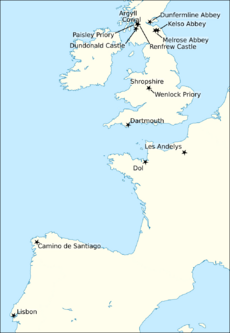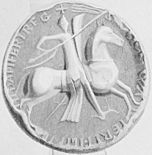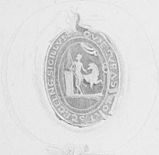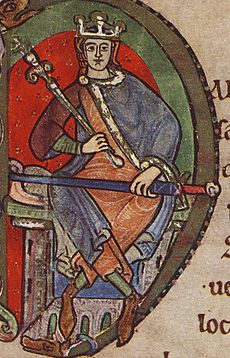Walter fitz Alan facts for kids
Quick facts for kids
Walter FitzAlan
|
|
|---|---|
| Steward of Scotland | |

Walter's name and title as it appears in a royal charter to Holyrood Abbey: "Walter filio alani Dapifero"
|
|
| Successor | Alan fitz Walter |
| Died | 1177 Melrose Abbey |
| Buried | Paisley Priory |
| Noble family | Fitz Alan family |
| Spouse(s) | Eschina de Londres |
| Issue |
|
| Father | Alan fitz Flaad |
| Mother | Avelina de Hesdin |
Walter FitzAlan (about 1106–1177) was an important noble from England who moved to Scotland in the 1100s. He became a powerful figure and the first Steward of Scotland. This job was like being the king's main helper.
Walter was a younger son of Alan fitz Flaad and Avelina de Hesdin. Around 1136, he started working for David I, King of Scotland. He became the king's steward around 1150. He served three Scottish kings: David I, Malcolm IV, and William I. Over time, the job of Steward became a family title, passed down through Walter's children.
Walter started as a less important noble in England. But when he came to Scotland, the kings gave him a lot of land. These lands were in western Scotland, including Mearns, Strathgryfe, Renfrew, and North Kyle. We are not sure where Walter's main home was, but it might have been Dundonald Castle or Renfrew Castle. Walter also gave money and land to several religious places. He was the person who started Paisley Priory.
Walter might have helped in the Siege of Lisbon in 1147 against the Moors. He probably also helped King Malcolm IV in battles against Fergus, Lord of Galloway in 1160. Walter and other nobles in western Scotland likely helped protect Scotland from dangers from places like Galloway and the Isles. In 1164, Somairle mac Gilla Brigte, King of the Isles attacked Scotland near Renfrew. It is possible that Walter led the Scottish forces who defeated him.
Walter was married to Eschina de Londres. She might have been from a family in southern Scotland. Walter and Eschina had a son named Alan, who took over his father's role. They might also have had a daughter named Christina. Walter was an ancestor of the Stewart family, which later became the royal Stewart/Stuart dynasty of Scotland and England. He passed away in 1177.
Contents
Walter's Family and Coming to Scotland
Walter was part of the Fitz Alan family. He was born around 1110. His father was Alan fitz Flaald (who died in 1121) and his mother was Avelina de Hesdin. Walter had two older brothers, Jordan and William.
Walter's father was a knight from Brittany, France. He was given land in England by Henry I, King of England. Walter's father had also been a "steward" for bishops in Brittany. Walter himself had some land in England, like North Stoke.
Walter likely came to Scotland around 1136. This was during the time of David I, King of Scotland. Walter's family supported David I's daughter, Matilda, in her fight for the English throne. Walter is mentioned in an old document from Melrose Abbey, which shows he was in Scotland by then.
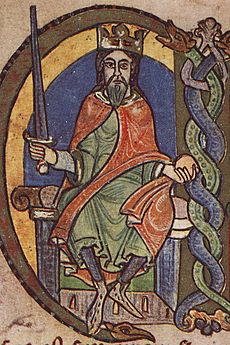
Walter worked as a steward for King David I. He continued this important job for King David's grandsons, Malcolm IV and William I. Walter is mentioned more often in royal documents from about 1150. It was around this time that King David I likely made the stewardship a family title for Walter.
As the king's steward, Walter was in charge of the king's daily household. He made sure the king's hall and meals were organized. Walter's family had experience as stewards in Brittany, so he knew a lot about the job.
In Walter's time, Scottish kings wanted to attract skilled people to their kingdom. They offered gifts of land to powerful nobles from other places, like the Anglo-Normans. These nobles helped the kings control more areas. Walter received large areas like Mearns, Strathgryfe, Renfrew, and North Kyle. Because of his high position and large lands, Walter was almost as powerful as the native Scottish earls.
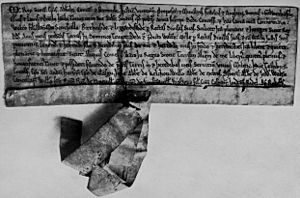
Between 1161 and 1162, King Malcolm IV officially confirmed Walter's role as steward. He also confirmed the lands King David had given Walter, like Renfrew and Paisley. Malcolm also gave Walter more lands, including West Partick and Inchinnan. For these lands, Walter had to provide five knights for the king's army. Walter also received land in every important town, showing how close he was to the king.
Walter also received North Kyle from either King David or King Malcolm. He also got the lands of Mow around 1161–1162. Most of Walter's lands were in Scotland, north of the border with England.
Religious Actions

Walter was very generous to religious places. He gave land in Mauchline to Melrose Abbey. He also gave land in Dunfermline and Inverkeithing to Dunfermline Abbey.
Walter founded Paisley Priory around 1163. This religious house was first built at Renfrew, near Renfrew Castle. But within a few years, it moved to Paisley. Walter chose to make it a Cluniac monastery. This might mean he was a big supporter of the Cluniac Wenlock Priory in England.
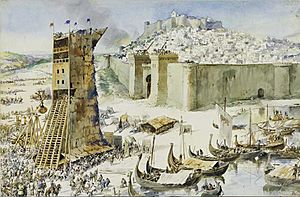
Walter's priory at Paisley was partly dedicated to St James the Greater. Also, Walter was not seen in King David's records for a few years (1143–1145). This might mean he went on a pilgrimage to a holy site for St James the Greater in Spain. In 1147, Scots joined an army of English and Flemish fighters. They went to join the Second Crusade. This army helped the King of Portugal in the Siege of Lisbon. It is possible that Walter was one of the Scots who took part in this battle.
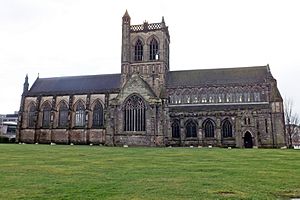
Renfrew might have been the main center of Walter's lands in Strathgryfe. However, some people think North Kyle was his most important area. For example, Walter gave a part of his income (a tithe) from all his lands to Paisley Priory, except for North Kyle. This suggests North Kyle was his largest and most important personal land. An old fort at Dundonald might show that Walter built Dundonald Castle there as his main base.
Walter's lands were home to people who spoke English, Cumbric, and Gaelic. Many of Walter's followers came from his family's lands in England. These areas in England were mostly Welsh-speaking. It is thought that Welsh, Breton, and Cumbric languages were similar back then. This might mean Walter and his followers were settled in western Scotland on purpose. They might have been seen as fellow "Britons" by the local people.
Eschina de Londres
Walter was married to Eschina de Londres. She was active between 1177 and 1198. It is likely that King David or King Malcolm arranged their marriage. Eschina's name "de Londres" suggests her father was from the Londres family. Her other name, "de Molle," might mean she inherited land in Mow from her mother's side.
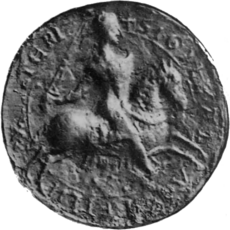
If Eschina did inherit Mow, then Walter might have been given this land by the king because of his marriage to her. However, it's also possible that she only gained rights to Mow because she married Walter.
Eschina was Walter's first wife. She lived longer than Walter. Her second husband was likely Henry de Cormunnock. Eschina's daughter, Margaret, was buried at Paisley Priory. Walter might also have had a daughter named Christina. Christina was married to William de Brus, Lord of Annandale and later to Patrick I, Earl of Dunbar.
Galloway
Walter was with King Malcolm IV in Normandy, France, in 1159. This shows that Walter was one of the Scottish nobles who went with the king on a military trip against the French. This is the only known time the king was on the European continent.
Malcolm returned to Scotland in 1160. He had to deal with a rebellion in Perth. After stopping the rebellion, Malcolm launched three military trips into Galloway. Although the old records do not name them, Walter was likely among the nobles who went with the king.
The reasons for these invasions are not fully clear. But Fergus, Lord of Galloway surrendered to the Scots that same year. Fergus was forced to retire to Holyrood Abbey and give his son, Uhtred, as a hostage to the king. Fergus might have caused the attacks by raiding Scottish lands. It's also possible that Fergus was working with Somairle mac Gilla Brigte, King of the Isles.
The Isles
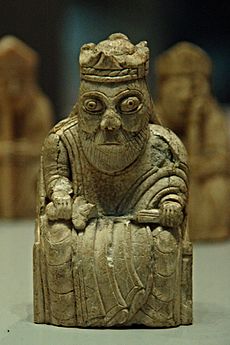
In 1164, Somairle attacked Scotland. This sea invasion is mentioned in many old writings. Somairle's forces came from Argyll, Dublin, and the Isles. This shows how powerful he was.
According to one old record, Somairle landed at Renfrew. He was defeated and killed by the local people. The fact that he landed at Renfrew might mean Walter was his target. It is not clear who led the Scottish forces. It could have been Herbert, Bishop of Glasgow, Baldwin, Sheriff of Lanark/Clydesdale, or Walter himself.
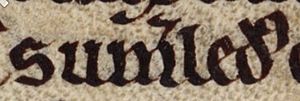
We don't know exactly why Somairle attacked the Scots. His power grew as Scottish royal power in Argyll seemed to weaken. Somairle might have seen himself as an independent ruler. In 1153, Somairle supported a failed attempt to take the Scottish throne after King David's death. Four years later, Somairle launched his last invasion of Scotland. He might have been trying to help this claim to the throne again.

Another reason for Somairle's attack could be that he wanted to take back land that Scotland had recently gained. These lands in Carrick, Kyle, Cunningham, and Strathgryfe were once controlled by the Gall Gaidheil, a people of mixed Viking and Gaelic background. It is possible that these lands became part of Scotland after King David defeated a rebellion in 1134.
Walter was also first mentioned in these old documents. He might have been given lands like Strathgryfe and Renfrew around 1136. One idea is that Somairle attacked because Walter and other new Scottish nobles were becoming a threat to his power. The death of Somairle's father-in-law, Óláfr Guðrøðarson, King of the Isles, in 1153 created a power gap. The Scots, especially Walter with his new lands, were in a good position to gain from this. Walter might have even started to expand his power into the Firth of Clyde and nearby islands.
The Scottish kings gave lands along the western coast to powerful nobles like Walter. This was likely to protect Scotland from threats from Galloway and the Isles. So, in the mid-1100s, Scotland gained more control over its western coast.
King Malcolm IV was often sick and died young. This, along with Somairle's growing power, might explain why Malcolm confirmed Walter's stewardship and lands in 1161–1162. Walter might have wanted written proof of his rights because of the dangers facing Scotland. Somairle might have even attacked because he knew the king was sick.
Death and Successors
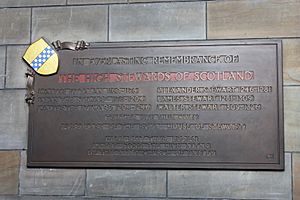
Walter served as steward until he died in 1177. Before he passed away, Walter went to Melrose Abbey and became a lay member (someone who lives a religious life but is not a monk). He was buried at Paisley Priory.
Walter's son, Alan, took over as steward. Later, Walter's great-grandson, Alexander Stewart, was the first to use the title "Steward of Scotland" instead of "steward of the king of Scotland." It was also around this time that Walter's family started using "Stewart" as their last name. Walter was the founder of the Stewart family, which later became the royal Stewart dynasty.


